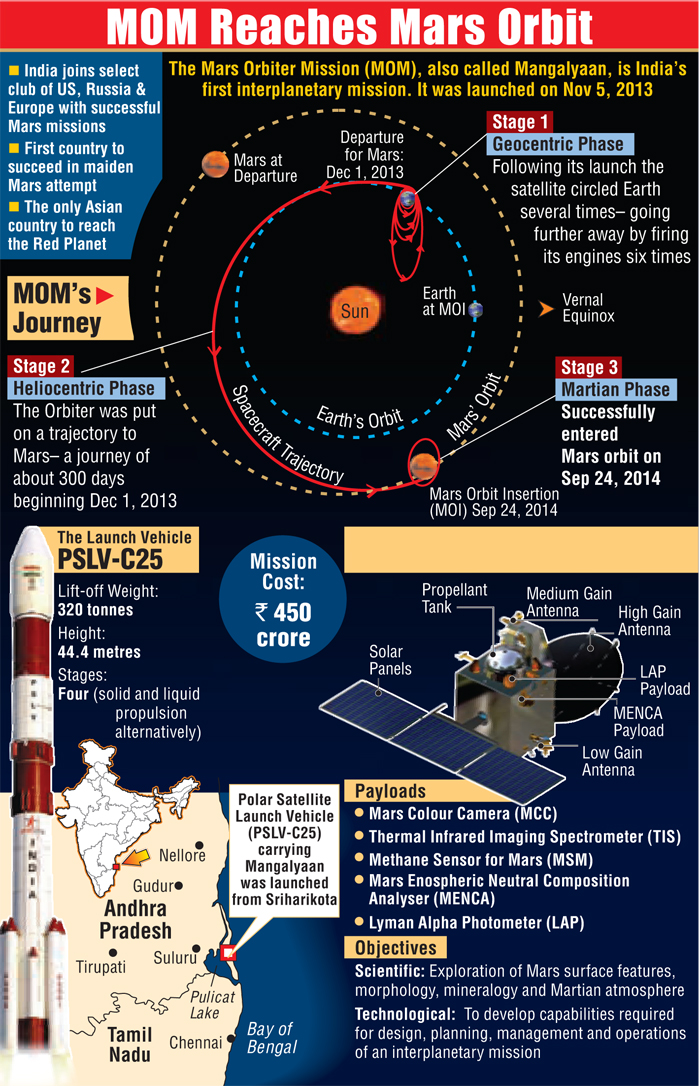MARS Mission Successful
Sakshi Education

India has created a history on 24th September by successfully inserting Mangalyaan into the Mars orbit. This achievement on its first attempt and at a cost less than what it takes to make a Hollywood movie brought accolades to the Indian Space Research Organisation.
The country’s space agency successfully completed the Mars Orbit Insertion (MOI) manoeuvre and with this, it joins the elite set of the US, Europe and Russia in successfully sending probes to orbit or land on Mars.
India becomes the first Asian country to go to the Red Planet, beating even China. The first sign of success on the very last leg came when ISRO announced that at the end of four hours, the burning of engines on India’s Mars orbiter had been confirmed.
For the next six months, the MOM will move in an elliptical path around the planet studying the Mars surface and scanning its atmosphere for methane. It will not land on Mars.
The spacecraft, launched on November 5, 2013 through a PSLV-XL rocket from Sriharikota in Andhra Pradesh, has travelled 666 million km (414 million miles) since.
The Mars Orbiter Mission (MOM) of the Indian Space Research Organisation (ISRO) is 100 per cent designed and developed in India.
Private partnerships
At least six ISRO labs collaborated with many private sector companies in the country to design and develop scientific equipment to deliver this sterling performance.
ISRO’s satellite, which has five scientific payloads, has travelled nearly 214 million km calculated under radio distance. Measured in heliocentric (solar) path, MOM has travelled nearly 660 million km. in transmission of satellite date to the earth ISRO took help of the US, Spain and Australia
Only Rs 450 crore spent
 The cost of the Mars Orbiter Mission is put at Rs 450 crore, which is one-fifth of the money spent by the US and European space agencies.
The cost of the Mars Orbiter Mission is put at Rs 450 crore, which is one-fifth of the money spent by the US and European space agencies.
European, American and Russian probes have managed to orbit or land on the planet, but after several attempts. The first Chinese mission to Mars, called Yinghuo-1, failed in 2011. Earlier in 1998, the Japanese mission ran out of fuel and was lost.
Oz antenna detects Orbiter entry
Australia on 24th September claimed credit score for detecting the Mangalyaan orbiter’s entry into Mars’ orbit. Canberra’s Deep Space Station forty three, the most important antenna within the Southern Hemisphere, acquired minute alerts from the Indian Space Research Organisation’s (ISRO) Mars Orbiter Mission (MOM) on Wednesday morning. The two nations have a Memorandum of Understanding on Civil Space Cooperation since 2012. Indian High Commission officers have been current at Deep Space Station forty three when the alerts have been acquired, stated the discharge
Important Points:
The country’s space agency successfully completed the Mars Orbit Insertion (MOI) manoeuvre and with this, it joins the elite set of the US, Europe and Russia in successfully sending probes to orbit or land on Mars.
India becomes the first Asian country to go to the Red Planet, beating even China. The first sign of success on the very last leg came when ISRO announced that at the end of four hours, the burning of engines on India’s Mars orbiter had been confirmed.
For the next six months, the MOM will move in an elliptical path around the planet studying the Mars surface and scanning its atmosphere for methane. It will not land on Mars.
The spacecraft, launched on November 5, 2013 through a PSLV-XL rocket from Sriharikota in Andhra Pradesh, has travelled 666 million km (414 million miles) since.
The Mars Orbiter Mission (MOM) of the Indian Space Research Organisation (ISRO) is 100 per cent designed and developed in India.
Private partnerships
At least six ISRO labs collaborated with many private sector companies in the country to design and develop scientific equipment to deliver this sterling performance.
ISRO’s satellite, which has five scientific payloads, has travelled nearly 214 million km calculated under radio distance. Measured in heliocentric (solar) path, MOM has travelled nearly 660 million km. in transmission of satellite date to the earth ISRO took help of the US, Spain and Australia
Only Rs 450 crore spent
 The cost of the Mars Orbiter Mission is put at Rs 450 crore, which is one-fifth of the money spent by the US and European space agencies.
The cost of the Mars Orbiter Mission is put at Rs 450 crore, which is one-fifth of the money spent by the US and European space agencies.European, American and Russian probes have managed to orbit or land on the planet, but after several attempts. The first Chinese mission to Mars, called Yinghuo-1, failed in 2011. Earlier in 1998, the Japanese mission ran out of fuel and was lost.
Oz antenna detects Orbiter entry
Australia on 24th September claimed credit score for detecting the Mangalyaan orbiter’s entry into Mars’ orbit. Canberra’s Deep Space Station forty three, the most important antenna within the Southern Hemisphere, acquired minute alerts from the Indian Space Research Organisation’s (ISRO) Mars Orbiter Mission (MOM) on Wednesday morning. The two nations have a Memorandum of Understanding on Civil Space Cooperation since 2012. Indian High Commission officers have been current at Deep Space Station forty three when the alerts have been acquired, stated the discharge
Important Points:
- After a journey of over 660 million kilometres that took 10 months, India’s Mars Orbiter Mission has swept with effortless ease into orbit around the Red Planet
- Till now only the United States, the former Soviet Union and the European Space Agency have succeeded in doing so.
- The Indian probe joins four spacecraft already circling Mars, including America’s MAVEN (acronym for Mars Atmosphere and Volatile Evolution) that went into orbit just two days earlier, as well as two U.S. rovers exploring the planet’s surface. The Indian and U.S. space agencies are holding discussions on possible scientific collaboration.
- India has created global history by becoming the first Asian nation to reach the Mars orbit in a space mission.
- On September 22, a mission by NASA called the Mars Atmosphere and Volatile Evolution (MAVEN), made at a cost of over $670 million, reached Mars. This Indian marathon took 300 days to cover a distance of over 670 million kilometres — a sprint really in a record time of 10 months.
- The first official hint that India was undertaking a mission to Mars came in the budget speech of 2012. Subsequently, the then Prime Minister Manmohan Singh formally declared in his Independence Day speech that year that an Indian mission was heading to Mars.
- The mission itself was launched on November 5, 2013
- Prime Minister Narendra Modi on his last visit to ISRO, when he witnessed the launch of a Polar Satellite Launch Vehicle, said India’s Mars orbiter is a “great achievement” since it costs less than the making of the Hollywood blockbuster movie “Gravity” which had a tag of $100 million.
- A few critics said why India should be sending a robotic mission to Mars when there is so much poverty, malnutrition, death, disaster and diseases among its 1.2 billon population, but analysis saiys that the cost of the Mars Orbiter mission of Rs.450 crore, for Indians it works out to be about Rs.4 per person.
- India’s Mars Orbiter mission has paved the way for cheaper and faster inter-planetary probes. During his upcoming U.S. visit, Mr. Modi and U.S. President Barack Obama are likely to sign a new agreement for the making of the joint Indo-U.S. Radar Satellite Mission. China and India recently signed an agreement on “peaceful uses of outer space.” So, many are now wanting to partner in ISRO’s success.
- The mission, within minutes of reaching Mars, has already taken its first images of the Martian surface. The Mars colour camera, which is essentially an Indian eye to track Mars, will bring back the first tangible truths to Indian taxpayers that their money has been well spent.
- If the 20th century witnessed a “space race” between the U.S. and the USSR, the 21st century is seeing an Asian space race. In most aspects of space technology, China is way ahead of India. It has larger rockets, bigger satellites and several rocket ports. It even launched its first astronaut in space way back in 2003 and has a space laboratory in the making.
- In 2008, when India undertook its first mission to moon Chandrayaan-1, China raced ahead and orbited its Chang’e-1 satellite ahead of India. But in this Martian marathon, India has reached the finish line ahead of China. This now puts India in the pole position as far as Asian Martian exploration goes.
- In 2012, the first Chinese probe to Mars Yinghuo-1 failed. It was riding atop a Russian satellite called Phobos-Grunt. But the Chinese probe failed to even leave earth.
- Earlier in 1998, a Japanese probe to Mars ran out of fuel.
Published date : 25 Sep 2014 05:06PM













